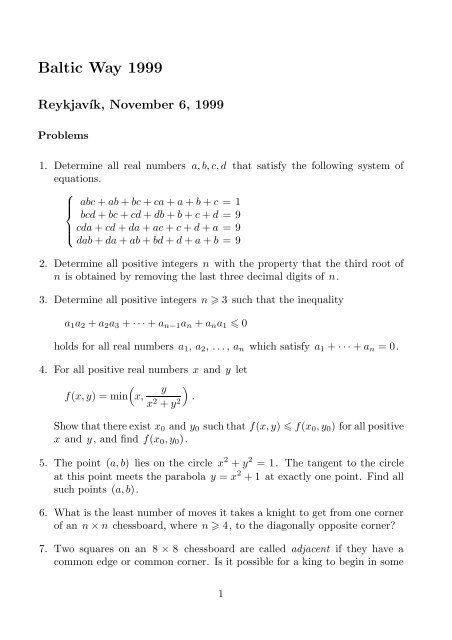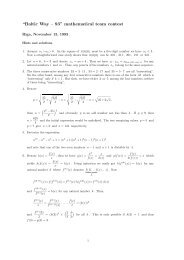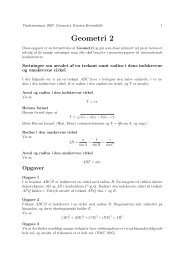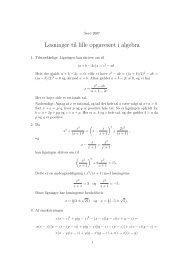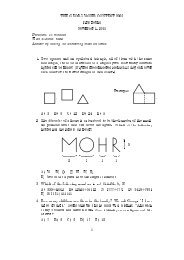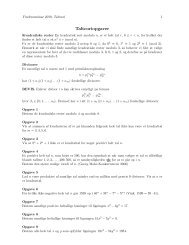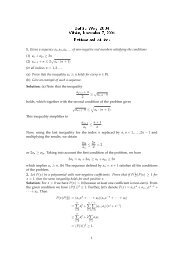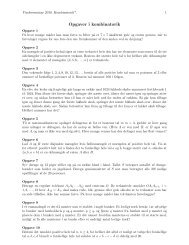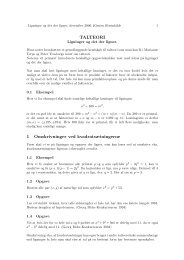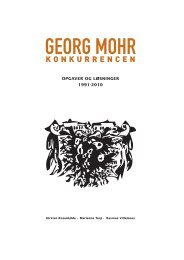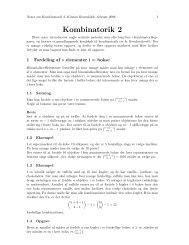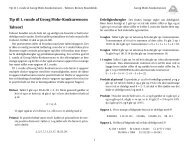Baltic Way 1999 - Georg Mohr-Konkurrencen
Baltic Way 1999 - Georg Mohr-Konkurrencen
Baltic Way 1999 - Georg Mohr-Konkurrencen
You also want an ePaper? Increase the reach of your titles
YUMPU automatically turns print PDFs into web optimized ePapers that Google loves.
square and visit all squares exactly once in such a way that all moves exceptthe first are made into squares adjacent to an even number of squares alreadyvisited?8. We are given <strong>1999</strong> coins. No two coins have the same weight. A machineis provided which allows us with one operation to determine, for any threecoins, which one has the middle weight. Prove that the coin that is the1000-th by weight can be determined using no more than 1 000 000 operationsand that this is the only coin whose position by weight can bedetermined using this machine.9. A cube with edge length 3 is divided into 27 unit cubes. The numbers1, 2, . . . , 27 are distributed arbitrarily over the unit cubes, with one numberin each cube. We form the 27 possible row sums (there are nine such sumsof three integers for each of the three directions parallel to the edges of thecube). At most how many of the 27 row sums can be odd?10. Can the points of a disc of radius 1 (including its circumference) be partitionedinto three subsets in such a way that no subset contains two pointsseparated by distance 1?11. Prove that for any four points in the plane, no three of which are collinear,there exists a circle such that three of the four points are on the circumferenceand the fourth point is either on the circumference or inside thecircle.12. In a triangle ABC it is given that 2|AB| = |AC| + |BC|. Prove that theincentre of ABC , the circumcentre of ABC , and the midpoints of AC andBC are concyclic.13. The bisectors of the angles A and B of the triangle ABC meet thesides BC and CA at the points D and E , respectively. Assuming that|AE| + |BD| = |AB|, determine the size of angle C .14. Let ABC be an isosceles triangle with |AB| = |AC|. Points D and E lieon the sides AB and AC , respectively. The line passing through B andparallel to AC meets the line DE at F . The line passing through C andparallel to AB meets the line DE at G. Prove that[DBCG][F BCE] = |AD||AE| , 2
where [P QRS] denotes the area of the quadrilateral P QRS .15. Let ABC be a triangle with ̸ C = 60 ◦ and |AC| < |BC|. The point Dlies on the side BC and satisfies |BD| = |AC|. The side AC is extendedto the point E where |AC| = |CE|. Prove that |AB| = |DE|.16. Find the smallest positive integer k which is representable in the formk = 19 n − 5 m for some positive integers m and n.17. Does there exist a finite sequence of integers c 1 , . . . , c n such that all thenumbers a + c 1 , . . . , a + c n are primes for more than one but not infinitelymany different integers a?18. Let m be a positive integer such that m ≡ 2 (mod 4). Show that thereexists at most one factorization√m = ab where a and b are positive integerssatisfying 0 < a − b < 5 + 4 √ 4m + 1.19. Prove that there exist infinitely many even positive integers k such that forevery prime p the number p 2 + k is composite.20. Let a, b, c and d be prime numbers such that a > 3b > 6c > 12d anda 2 − b 2 + c 2 − d 2 = 1749. Determine all possible values of a 2 + b 2 + c 2 + d 2 .Solutions1. Answer: a = b = c = 3√ 2 − 1, d = 5 3√ 2 − 1.Substituting A = a + 1, B = b + 1, C = c + 1, D = d + 1, we obtainABC = 2 (1)BCD = 10 (2)CDA = 10 (3)DAB = 10 (4)Multiplying (1), (2), (3) gives C 3 (ABD) 2 = 200, which together with (4)implies C 3 = 2. Similarly we find A 3 = B 3 = 2 and D 3 = 250. Thereforethe only solution is a = b = c = 3√ 2 − 1, d = 5 3√ 2 − 1.2. Answer: 32768 is the only such integer.3
If n = m 3 is a solution, then m satisfies 1000m m 3 < 1000(m + 1).From the first inequality, we get m 2 1000, or m 32. By the secondinequality, we then havem 2 < 1000 · m + 1m33 1000 1000 · = 1000 +32 32 1032 ,or m 32. Hence, m = 32 and n = m 3 = 32768 is the only solution.3. Answer: n = 3 and n = 4.For n = 3 we havea 1 a 2 + a 2 a 3 + a 3 a 1 = (a 1 + a 2 + a 3 ) 2 − (a 2 1 + a 3 2 + a 2 3)2 (a 1 + a 2 + a 3 ) 22= 0 .For n = 4, applying the AM-GM inequality we havea 1 a 2 + a 2 a 3 + a 3 a 4 + a 4 a 1 = (a 1 + a 3 )(a 2 + a 4 ) (a 1 + a 2 + a 3 + a 4 ) 24= 0 .For n 5 take a 1 = −1, a 2 = −2, a 3 = a 4 = · · · = a n−2 = 0, a n−1 = 2,a n = 1. This givesa 1 a 2 + a 2 a 3 + . . . + a n−1 a n + a n a 1 = 2 + 2 − 1 = 3 > 0 .( 14. Answer: the maximum value is f √2 ,1)√ = √ 1 . 2 2We shall make use of the inequality x 2 + y 2 2xy . If x x yx 2 + y 2 y2xy = 12x ,yx 2 + y 2 , thenimplying x 1 √2, and the equality holds if and only if x = y = 1 √2.4
If x > 1 √2, thenyx 2 + y 2 y2xy = 12x < √ 1 . 2y1Hence always at least one of x andx 2 does not exceed √ . Consequentlyf(x, y) √ 1 , with an equality if and only if x = y = √ 1 .2+ y2 225. Answer: (−1, 0), (1, 0), (0, 1),(− 2√ 6) ( √2 6)5 , −1 ,5 5 , −1 .5Since any non-vertical line intersecting the parabola y = x 2 + 1 has exactlytwo intersection points with it, the line mentioned in the problem must beeither vertical or a common tangent to the circle and the parabola. The onlyvertical lines with the required property are the lines x = 1 and x = −1,which meet the circle in the points (1, 0) and (−1, 0), respectively.Now, consider a line y = kx + l. It touches the circle if and only if thesystem of equations{x 2 + y 2 = 1y = kx + l(5)has a unique solution, or equivalently the equation x 2 + (kx + l) 2 = 1 hasunique solution, i.e. if and only ifD 1 = 4k 2 l 2 − 4(1 + k 2 )(l 2 − 1) = 4(k 2 − l 2 + 1) = 0 ,or l 2 − k 2 = 1. The line is tangent to the parabola if and only if the system{y = x 2 + 1y = kx + lhas a unique solution, or equivalently the equation x 2 = kx + l − 1 hasunique solution, i.e. if and only ifD 2 = k 2 − 4(1 − l) = k 2 + 4l − 4 = 0 .5
From the system of equations{ l 2 − k 2 = 1k 2 + 4l − 4 = 0we have l 2 + 4l − 5 = 0, which has two solutions l = 1 and l = −5. Hencethe last system of equations has the solutions k = 0, l = 1 and k = ±2 √ 6,(l = −5. From (5) we now have (0, 1) and ± 2√ 6)5 , −1 as the possible5points of tangency on the circle.⌊ n + 1⌋6. Answer: 2 · .3Label the squares by pairs of integers (x, y), x, y = 1, . . . , n, and consider asequence of moves that takes the knight from square (1, 1) to square (n, n).The total increment of x+y is 2(n−1), and the maximal increment in eachmove is 3. Furthermore, the parity of x + y shifts in each move, and 1 + 1and n + n are both even. Hence, the number of moves is even and larger2 · (n − 1)than or equal to . If N = 2m is the least integer that satisfies3these conditions, then m is the least integer that satisfies m n − 1 , i.e.3⌊ n + 1⌋m = .3eplacementsn = 4 n = 5 n = 6Figure 1For n = 4, n = 5 and n = 6 the sequences of moves are easily found thattake the knight from square (1, 1) to square (n, n) in 2, 4 and 4 moves,6
espectively (see Figure 1). In particular, the knight may get from square(k, k) to square (k + 3, k + 3) in 2 moves. Hence, by simple induction, forany n the knight can get from square (1, 1) to square (n, n) in a numbern + 1of moves equal to twice the integer part of , which is the minimal3possible number of moves.7. Answer: No, it is not possible.Consider the set S of all (non-ordered) pairs of adjacent squares. Call anelement of S treated if the king has visited both its squares. After the firstmove there is one treated pair. Each subsequent move creates a further evennumber of treated pairs. So after each move the total number of treatedpairs is odd. If the king could complete his tour then the total numberof pairs of adjacent squares (i.e. the number of elements of S ) would haveto be odd. But the number of elements of S is even as can be seen bythe following argument. Rotation by 180 degrees around the centre of theboard induces a bijection of S onto itself. This bijection leaves preciselytwo pairs fixed, namely the pairs of squares sharing only a common cornerat the middle of the board. It follows that the number of elements of S iseven.8. It is possible to find the 1000-th coin (i.e. the medium one among the <strong>1999</strong>coins). First we exclude the lightest and heaviest coin — for this we use1997 weighings, putting the medium-weighted coin aside each time. Nextwe exclude the 2-nd and 1998-th coins using 1995 weighings, etc. In totalwe need1997 + 1995 + 1993 + . . . + 3 + 1 = 999 · 999 < 1000000weighings to determine the 1000-th coin in such a way.It is not possible to determine the position by weight of any other coin,since we cannot distinguish between the k -th and (2000−k)-th coin. Toprove this, label the coins in some order as a 1 , a 2 , . . . , a <strong>1999</strong> . If a procedurefor finding the k -th coin exists then it should work as follows. First wechoose some three coins a i1 , a j1 , a k1 , find the medium-weighted one amongthem, then choose again some three coins a i2 , a j2 , a k2 (possibly using theinformation obtained from the previous weighing) etc. The results of these7
weighings can be written in a table like this:Coin 1 Coin 2 Coin 3 Mediuma i1 a j1 a k1 a m1a i2 a j2 a k2 a m2. . . . . . . . . . . .a in a jn a kn a mnSuppose we make a decision “a k is the k -th coin” based on this table. Nowlet us exchange labels of the lightest and the heaviest coins, of the 2-nd and1998-th (by weight) coins etc. It is easy to see that, after this relabeling,each step in the procedure above gives the same result as before — but ifa k was previously the k -th coin by weight, then now it is the (2000−k)-thcoin, so the procedure yields a wrong coin which gives us the contradiction.9. Answer: 24.Since each unit cube contributes to exactly three of the row sums, then thetotal of all the 27 row sums is 3 · (1 + 2 + . . . + 27) = 3 · 14 · 27, which iseven. Hence there must be an even number of odd row sums.+ + + + − − + + −− ++ −++(a) (b) I II IIIFigure 2 Figure 3+ + − − − −− + + − − −+ − + − + −We shall prove that if one of the three levels of the cube (in any givendirection) contains an even row sum, then there is another even row sumwithin that same level — hence there cannot be 26 odd row sums. Indeed,if this even row sum is formed by three even numbers (case (a) on Figure 2,where + denotes an even number and − denotes an odd number), thenin order not to have even column sums (i.e. row sums in the perpendiculardirection), we must have another even number in each of the three columns.But then the two remaining rows contain three even and three odd numbers,and hence their row sums cannot both be odd. Consider now the other casewhen the even row sum is formed by one even number and two odd numbers(case (b) on Figure 2). In order not to have even column sums, the column8
containing the even number must contain another even number and an oddnumber, and each of the other two columns must have two numbers of thesame parity. Hence the two other row sums have different parity, and oneof them must be even.It remains to notice that we can achieve 24 odd row sums (see Figure 3,where the three levels of the cube are shown).10. Answer: no.Let O denote the centre of the disc, and P 1 , . . . , P 6 the vertices of aninscribed regular hexagon in the natural order (see Figure 4).If the required partitioning exists, then {O}, {P 1 , P 3 , P 5 } and {P 2 , P 4 , P 6 }are contained in different subsets. Now consider the circles of radius 1 centeredin P 1 , P 3 and P 5 . The circle of radius 1/ √ 3 centered in O intersectsthese three circles in the vertices A 1 , A 2 , A 3 of an equilateral triangle ofside length 1. The vertices of this triangle belong to different subsets, butnone of them can belong to the same subset as P 1 — a contradiction. HencePSfrag replacementsthe required partitioning does not exist.n = 4n = 5P 4n = 6P 5A 2P 3¥¡¥¦¡ ¢A 1PA 36£¡£¤OP 1P 2Figure 411. Consider a circle containing all these four points in its interior. First, decreaseits radius until at least one of these points (say, A) will be on thecircle. If the other three points are still in the interior of the circle, thenrotate the circle around A (with its radius unchanged) until at least one ofthe other three points (say, B ) will also be on the circle. The centre of thecircle now lies on the perpendicular bisector of the segment AB — moving9
"!n = 4n = 5n = 6P 1P 2P 3the centre along that perpendicular bisector (and changing its radius at thesame P 4 time, so that points A and B remain on the circle) we arrive at asituation P 5 where at least one of the remaining two points will also be on thecircle P 6 (see Figure 5).A 1A 2¡ §¡§¡¨¡¨ ¡#¡# $¡$Areplacements 3D CD CODC¡¡n ¡= ¡4 ¡OOn¡= 5O¡ ¡n = 6P©¡© ¡¡ ¡1¡ ¡A BABAP 2BP 3P 4Figure 5P 5Alternative P 6 solution. The quadrangle with its vertices in the four points canbe convex or non-convex.A 1A 2If the quadrangle is non-convex, then one of the points lies in the interiorof A 3 the triangle defined by the remaining three points (see Figure 6) – thecircumcircle O of that triangle has the required property.ABCCDODADAD ′ O)()C%&'('BBFigure 6 Figure 7Assume now that the quadrangle ABCD (where A, B, C, D are the fourpoints) is convex. Then it has a pair of opposite angles, the sum of whichis at least 180 ◦ — assume these are at vertices B and D (see Figure 7).We shall prove that point D lies either in the interior of the circumcircleof triangle ABC or on that circle. Indeed, let the ray drawn from the10
eplacementsn = circumcentre 4 O of triangle ABC through point D intersect the circumcirclen = in5D ′ : since ̸ B + ̸ D ′ = 180 ◦ and ̸ B + ̸ D 180 ◦ , then D cannot lien = in6the exterior of the circumcircle.P 1̸ ̸̸ ̸12. Let P 2N be the midpoint of BC and M the midpoint of AC . Let Obe P 3the circumcentre of ABC and I its incentre (see Figure 8). SincePCMO 4= CNO = 90 ◦ , the points C , N , O and M are concyclic (regardlessP 5of whether O lies inside the triangle ABC ). We now have toshow P 6that the points C , N , I and M are also concyclic, i.e I lies onthe A 1same circle as C , N , O and M . It will be sufficient to show thatNCM + NIM = 180 ◦ in the quadrilateral CNIM . SinceA 2A 3|AC| + |BC|O|AB| = = |AM| + |BN| ,2Awe B can choose a point D on the side AB such that |AD| = |AM| and|BD| C = |BN|. Then triangle AIM is congruent to triangle AID , andsimilarly D triangle BIN is congruent to triangle BID . ThereforeO̸ NCM + ̸ NIM = ̸ANCM + (360 ◦ − 2̸ AID − 2̸ BID) =B= ̸ BCA + 360 ◦ − 2̸ AIB =C(= ̸ BCA + 360 ◦ − 2 · 180 ◦ − ̸ BAC− ̸ ABC)D=2 2D ′= ̸ BCA + ̸ ABC + ̸ CAB = 180 ◦ .OCC⃗e 1⃗e 2MIONMHIOGNABAKBFigure 8 Figure 9Alternative solution.Let O be the circumcentre of ABC and I its in-11
centre, and let G, H and K be the points where the incircle touchesthe sides BC , AC and AB of the triangle, respectively. Also, let N bethe midpoint of BC and M the midpoint of AC (see Figure 9). Since̸ CMO = ̸ CNO = 90 ◦ , points M and N lie on the circle with diameterOC . We will show that point I also lies on that circle. Indeed, wehave|AH| + |BG| = |AK| + |BK| = |AB| =|AC| + |BC|2= |AM| + |BN| ,implying |MH| = |NG|. Since MH and NG are the perpendicular projectionsof OI to the lines AC and BC , respectively, then IO must beeither parallel or perpendicular to the bisector CI of angle ACB . (Toformally prove this, consider unit vectors ⃗e 1 and ⃗e 2 defined by the raysCA and CB , and show that the condition |MH| = |NG| is equivalent to( ⃗e 1 ± ⃗e 2 ) · −→ IO = 0.)If IO is perpendicular to CI , then ̸ CIO = 90 ◦ and we are done. IfIO is parallel to CI , the the circumcentre O of triangle ABC lies onthe bisector CI of angle ACB , whence |AC| = |BC| and the condition2|AB| = |AC| + |BC| implies that ABC is an equilateral triangle. Hencein this case points O and I coincide and the claim of the problem holdstrivially.13. Answer: 60 ◦ .Let F be the point of the side AB such that |AF | = |AE| and |BF | = |BD|(see Figure 10). The line AD is the angle bisector of ̸ A in the isoscelestriangle AEF . This implies that AD is the perpendicular bisectorof EF , whence |DE| = |DF |. Similarly we show that |DE| = |EF |.This proves that the triangle DEF is equilateral, i.e. ̸ EF D = 60 ◦ .Hence ̸ AF E + ̸ BF D = 120 ◦ , and also ̸ AEF + ̸ BDF = 120 ◦ . Thus̸ CAB + ̸ CBA = 120 ◦ and finally ̸ C = 60 ◦ .Alternative solution. Let I be the incenter of triangle ABC , and let G,H , K be the points where its incircle touches the sides BC , AC , ABrespectively (see Figure 11). Then|AE| + |BD| = |AB| = |AK| + |BK| = |AH| + |BG| ,implying |DG| = |EH|. Hence the triangles DIG ja EIH are congruent,12
MNKHGIand⃗e 1⃗e 2 ̸ DIE = ̸ GIH = 180 ◦ − ̸ C .OCCEIDEHIGDAFBAKBFigure 10 Figure 11On the other hand,̸ DIE = ̸ AIB = 180 ◦ − ̸ A + ̸ B2Hence̸ C = ̸ A + ̸ B2which gives ̸ C = 60 ◦ .= 90 ◦ − ̸ C2 ,.14. The quadrilaterals DBCG and F BCE are trapeziums. The area of atrapezium is equal to half the sum of the lengths of the parallel sides multipliedby the distance between them. But the distance between the parallelsides is the same for both of these trapeziums, since the distance from Bto AC is equal to the distance from C to AB . It therefore suffices to showthat|BD| + |CG||CE| + |BF | = |AD||AE|(see Figure 12).similar, we haveNow, since the triangles BDF , ADE and CGE are|BD||BF | = |CG||CE| = |AD||AE| , 13
DEFKHwhichGimplies the required equality.IEGCEGCF ′ADADMFBFBG ′Figure 12 Figure 13Alternative solution. As in the first solution, we need to show that|BD| + |CG||BF | + |CE| = |AD||AE| .Let M be the midpoint of BC , and let F ′ and G ′ be the points symmetricto F and G, respectively, relative to M (see Figure 13). Since CG isparallel to AB , then point G ′ lies on the line AB , and |BG ′ | = |CG|.Similarly point F ′ lies on the line AC , and |CF ′ | = |BF |. It remains toshow that|DG ′ ||EF ′ | = |AD||AE| ,which follows from DE and F ′ G ′ being parallel.Another solution. Express the areas of the quadrilaterals asand[DBCG] = [ABC] − [ADE] + [ECG][F BCE] = [ABC] − [ADE] + [DBF ] .The required equality can now be proved by direct computation.15. Consider a point F on BC such that |CF | = |BD| (see Figure 14). Since̸ ACF = 60 ◦ , triangle ACF is equilateral. Therefore |AF | = |AC| = |CE|14
andIABCDAFEB = ECD = 120 ◦ . Moreover, |BF | = |CD|. This implies thattrianglesFAF B and ECD are congruent, and |AB| = |DE|.GF ′ EG ′MC60 ◦ FFigure 14DABAlternative solution. The cosine law in triangle ABC implies|AB| 2 = |AC| 2 + |BC| 2 − 2 · |AC| · |BC| · cos ̸ ACB == |AC| 2 + |BC| 2 − |AC| · |BC| == |AC| 2 + (|BD| + |DC|) 2 − |AC| · (|BD| + |DC|) == |AC| 2 + (|AC| + |DC|) 2 − |AC| · (|AC| + |DC|) == |AC| 2 + |DC| 2 + |AC| · |DC|On the other hand, the cosine law in triangle CDE gives|DE| 2 = |DC| 2 + |CE| 2 − 2 · |DC| · |CE| · cos ̸ DCE == |DC| 2 + |CE| 2 + |DC| · |EC| == |DC| 2 + |AC| 2 + |DC| · |AC| .Hence |AB| = |DE|.16. Answer: 14.Assume that there are integers n, m such that k = 19 n − 5 m is a positiveinteger smaller than 19 1 − 5 1 = 14. For obvious reasons, n and m must bepositive.Case 1: Assume that n is even. Then the last digit of k is 6. Consequently,we have 19 n − 5 m = 6. Considering this equation modulo 3 implies that m15
must be even as well. With n = 2n ′ and m = 2m ′ the above equation canbe restated as (19 n′ + 5 m′ )(19 n′ − 5 m′ ) = 6 which evidently has no solutionin positive integers.Case 2: Assume that n is odd. Then the last digit of k is 4. Consequently,we have 19 n − 5 m = 4. On the other hand, the remainder of 19 n − 5 mmodulo 3 is never 1, a contradiction.17. Answer: yes.Let n = 5 and consider the integers 0, 2, 8, 14, 26. Adding a = 3 or a = 5to all of these integers we get primes. Since the numbers 0, 2, 8, 14 and26 have pairwise different remainders modulo 5 then for any integer a thenumbers a + 0, a + 2, a + 8, a + 14 and a + 26 have also pairwise differentremainders modulo 5; therefore one of them is divisible by 5. Hence if thenumbers a + 0, a + 2, a + 8, a + 14 and a + 26 are all primes then one ofthem must be equal to 5, which is only true for a = 3 and a = 5.18. Squaring the second inequality gives (a − b) 2 < 5 + 4 √ 4m + 1. Sincem = ab, we have(a + b) 2 < 5 + 4 √ 4m + 1 + 4m = ( √ 4m + 1 + 2) 2 ,implyinga + b < √ 4m + 1 + 2 .Since a > b, different factorizations m = ab will give different values forthe sum a + b (ab = m, a + b = k, a > b has at most one solution in (a, b)).Since m ≡ 2 (mod 4), we see that a and b must have different parity, anda + b must be odd. Also note thata + b 2 √ ab = √ 4m .Since 4m cannot be a square we havea + b √ 4m + 1 .Since a + b is odd and the interval [ √ 4m + 1, √ 4m + 1 + 2 ) contains exactlyone odd integer, then there can be at most one pair (a, b) such thata + b < √ √4m + 1 + 2, or equivalently a − b < 5 + 4 √ 4m + 1.19. Note that the square of any prime p ≠ 3 is congruent to 1 modulo 3. Hencethe numbers k = 6m + 2 will have the required property for any p ≠ 3, as16
p 2 + k will be divisible by 3 and hence composite.In order to have 3 2 +k also composite, we look for such values of m for whichk = 6m + 2 is congruent to 1 modulo 5 — then 3 2 + k will be divisibleby 5 and hence composite. Taking m = 5t + 4, we have k = 30t + 26,which is congruent to 2 modulo 3 and congruent to 1 modulo 5. Hencep 2 + (30t + 26) is composite for any positive integer t and prime p.20. Answer: the only possible value is <strong>1999</strong>.Since a 2 − b 2 + c 2 − d 2 is odd, one of the primes a, b, c and d must be 2,and in view of a > 3b > 6c > 12d we must have d = 2. Now1749 = a 2 − b 2 + c 2 − d 2 > 9b 2 − b 2 + 4d 2 − d 2 = 8b 2 − 12 ,implying b 13. From 4 < c < b 2we now have c = 5 and b must be either11 or 13. It remains to check that 1749 + 2 2 − 5 2 + 13 2 = 1897 is not asquare of an integer, and 1749 + 2 2 − 5 2 + 11 2 = 1849 = 43 2 . Hence b = 11,a = 43 anda 2 + b 2 + c 2 + d 2 = 43 2 + 11 2 + 5 2 + 2 2 = <strong>1999</strong> .17


